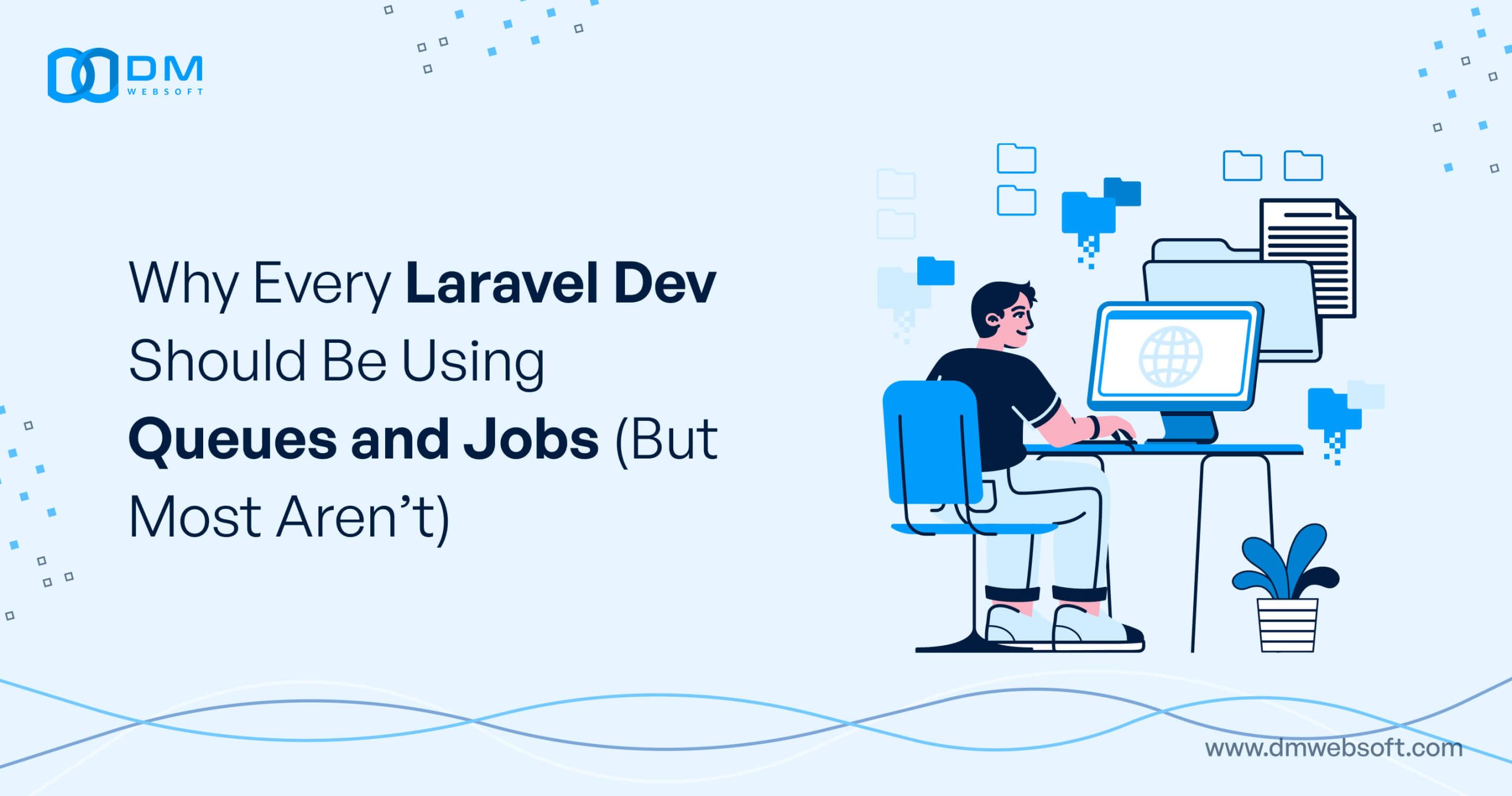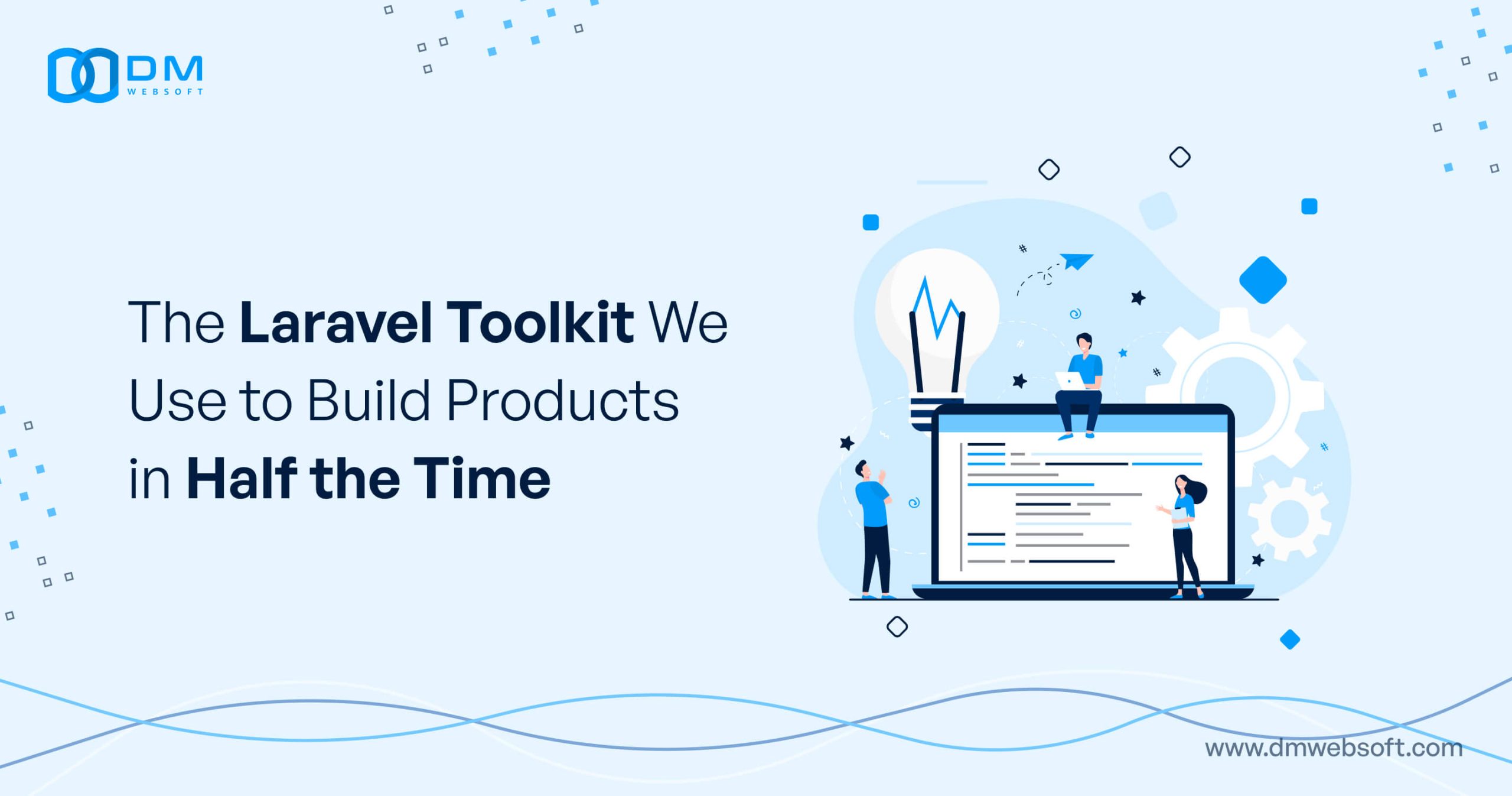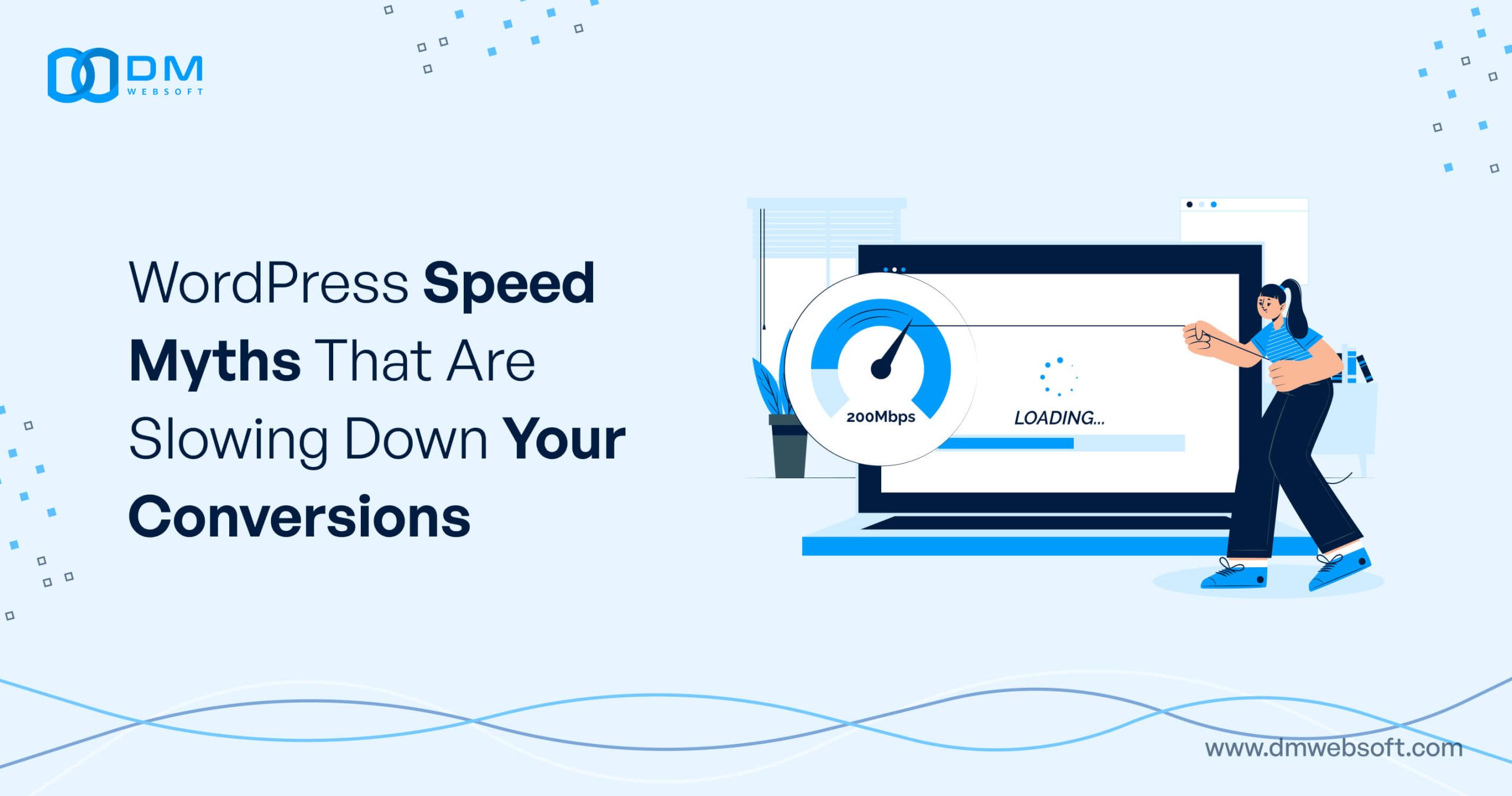DM WebSoft LLP exceeded our expectations! Their seasoned team of experts delivered a website that perfectly captures our brand essence. Their 15+ years of experience truly shine through in their exceptional web development skills.
Easy Steps to Set Up Your First Laravel Project

TABLE OF CONTENT
Introduction
Setting the Foundation: Preliminary Requirements for Laravel
Additional Considerations for Optimal Setup
Step-by-Step Guide to Setting Up Your First Laravel Project
Overcoming Common Challenges in Laravel Setup
Real-Life Success: Case Studies from DM WebSoft
Laravel in the Current Market: Research and Trends
Market Trends and Future Outlook
Conclusion
Get in Touch
Introduction

Laravel is the new PHP web framework for web artisans that is developed for fast-changing environments with the development of full-featured web applications. With an elegant syntax like that, Laravel has established itself as the choice for many, coupling performance with ease of use, so your project is sure to be both successful and a joy to work on.
At DM WebSoft LLP, we do understand the intricacies of website development. We have a focused team of professional developers who deliver the best using Laravel for every result—all customized as per the individual requirements of every client. It is applicable in any of the following cases: from designing a small business website to engineering a complex enterprise system. It takes care of each project being made with precision and care.
In this blog post, we will guide you through the necessary steps to set up your first Laravel project. We will support you from setting up the first server up to running your very first Laravel application, providing all the tips and tools that might be needed.
We will also provide insights on how to overcome common challenges at setup and, most importantly, share real-life case studies from our portfolio. We will also analyze current market research around why Laravel is a top choice among developers today. Join us and be part of this interesting journey to reveal and experience the full potential of Laravel, allowing your web development to be very enhanced with expert help from DM WebSoft LLP.
Setting the Foundation: Preliminary Requirements for Laravel
Laravel Project: It starts with a development environment that is ready for work—primed and primmed for the development environment, which will not be the technical ground but rather very useful for convenience during development and efficient work. Here, we delve into the key requirements and configurations necessary to prepare for a successful Laravel deployment.
Be it optimizing your environment for Laravel or any other tick, rest assured that with expert guidance from DM WebSoft LLP, each and every possible thing would be checked and optimized to set a good foundation for your development effort.
Essential Server Requirements
Architecture is designed in such a way that it can leverage the best features of modern web servers and programming practices. This is because your server environment must meet some specific requirements set by Laravel.
- PHP Version: Any project that is based on Laravel should have a PHP version 7.3 or higher. Harmonizing the syntax and features allows realizing most of the latest PHP improvements for better performance and security.
- Web Server Software: Laravel can run under any server software of your choice, including Nginx and Apache. It will be necessary to have mod_rewrite in Apache, which should be on, as it enables support for Laravel’s application-based routing. Some configuration files can be specific to Nginx to process PHP files by the PHP-FPM service correctly.
- Database Engine: As of now, Laravel supports some databases like MySQL, PostgreSQL, SQLite, and SQL Server. The selection of the database usually comes about by the scale of project database and specific requirements for managing the data. This is done to ensure that the database operation is uninterrupted when working with data operations within the Laravel application. The database connection configuration is the next step.
- Composer: An essential PHP dependency manager used in the management of components of Laravel and many other dependencies. It is advised to install Composer properly, as it is quite likely to be used for managing the libraries and handling autoloading standards.
Configuring the Development Environment
Proper environment configuration is critical for maintaining the security and efficiency of your Laravel project:
- Environment Variables: An environment settings value holder and changer without necessary changes within the code files are done in Laravel. The .env file contains connection details of the database, mail settings details, and other parameters related to the environment in a secure environment.
- Key Configuration and Security: Another important step is to set up the application key with the php artisan key:generate command of Laravel. This gets used to encrypting cookies, session data, and other important information. It should never be exposed, and it must be unique.
- PHP extensions required: At the very onset, in order to derive the best from what Laravel offers, the server should support a number of PHP extensions: OpenSSL, PDO, Mbstring, Tokenizer, XML, Ctype, and JSON, among many others. They find their use not only for data encryption but also in parsing XML to complex string operations used in a lot of functions and mechanisms.
Additional Considerations for Optimal Setup
Step-by-Step Guide to Setting Up Your First Laravel Project

Setting up your first Laravel project is one exciting step into the world of web development. With that set of intuitive features and powerful capabilities, you’ll be on your way to building something really great. Following are the steps and practical tips that guide you through the whole process based on my experience from many years of working at DM WebSoft LLP.
We tried to make this setup as simple and comprehensible as we could, even if you’re kind of new to using frameworks like Laravel.
Step 1: Install Composer
First and foremost, you would require Composer—PHP dependency manager. It shall help in managing the dependencies for your Laravel project and checking that you have all the required elements set up.
First of all, download and install Composer. Visit the official site of Composer for your OS, and follow mentioned installation instruction on your system. Do install it globally, because it has to be available in the system path; this makes it possible for you to run commands from your terminal or command prompt from anywhere.
Verify installed: After that, please ensure that the Composer has been installed correctly. To verify if it is installed correctly, you can do so by running the terminal and typing composer. It should return you some version information with the list of commands. Then you are ready to go!
Step 2: Create a New Laravel Project
With Composer installed, we are now going to set up our very first project using Laravel. This can be done either by using the Laravel installer or directly by Composer. We shall create our very first Laravel project using Composer because this has already been set up from the previous step.
Create the project: Run the following command in your terminal: composer create-project –prefer-dist laravel/laravel yourProjectName
Replace yourProjectName above with the project name you intend to give it. The following command will prompt Composer to download and install a fresh Laravel installation along with all necessary dependencies into a new directory that it creates and names after your project.
Wait for the process to finish; this may take some minutes as it pulls in the required packages. At last, it sets up the directory structure for your new Laravel project.
Step 3: Configure Your Environment
Once your project is created, you need to set up the environment configurations.
.env file setup: Find the .env file at the root of your directory project. The file is important, since it helps in keeping settings of your environment, such as the app key, database, among other configurations.
Generate Application Key: Laravel requires an application key that should be unique for encrypting sessions and other sensitive data. You may run the command below to generate an application key: php artisan key:generate
This command will automatically generate a safe key and update your .env file with it. This is one of the pretty much important practices to make your Laravel application secure.
Step 4: Set Up the Database
Laravel makes it easy to set up a database connection through the .env file.
Setup the database settings:
Ensure that this configuration corresponds to the database credentials that your Laravel project will point to.
Step 5: Run the Laravel Application
Now, with everything set up, it’s time to see your new Laravel application in action. Serve your application: With Laravel comes pre-installed an Artisan command that serves the application and sets up a development environment pretty fast. Run the below command from your project directory to serve the application.
php artisan serve: This runs the development server at http://localhost:8000.. In case of any problems or if additional customization is required during the process, do not hesitate to contact us. Our experts provide tailor-made solutions to ensure that it is starting on the right foot and then running steadily while scaling.
Overcoming Common Challenges in Laravel Setup

As you get started in setting up your Laravel project, there could be quite a number of challenges that might stall you in some of your forward movements. These are common hurdles and are generally known to be associated by beginners in Laravel or seasoned developers with some sorts of unique project requirements.
In DM WebSoft LLP, we have seen such challenges on myriad occasions, and now we bring to you learning that will make you move like a breeze on these common but critical issues.
Permission Issues
One common challenge that developers come across while setting up a Laravel project is that of permission errors. The couple of directories need write permission by the web server for them to be operational with Laravel. Such directories include storage, together with its subdirectories, and the bootstrap/cache directory.
Solution: Ensure correct permissions by running the following commands:
Adjust the path and user (www-data) as needed. This sets the needed file permissions for the web server to write while still maintaining security of the file permissions.
Environment Configuration Errors
Misconfiguration in the .env file results in database connection errors, failure in sending mail, and other fatal issues combined that stop Laravel from working fine.
Solution: Please recheck your .env settings and make sure that each entry is as expected; it should be done correctly, free from syntax error or missing value. It’s always good advice that, after editing the .env file, you should run the command php artisan config:clear to clear the configuration cache so that Laravel uses your updated settings.
Composer Dependency Problems
Sometimes, on updating or installing Laravel via Composer, the expected dependency conflicts or missed packages occur. This becomes a frustrating debugging.
Solution: First, run composer install and make sure that all packages have been installed appropriately. If still the problem, then do the composer update to update all dependencies. You may also have to add more compatible version constraints in your composer.json file.
Localization and Timezone Issues
Laravel defaults to UTC for timezone and uses English as its localization. Should your application run past that, failure to configure the settings might leave you with issues on timestamping, dates and date calculations, and even multilingual support.
Solution: Change the timezone according to the given requirement in the file config/app.php and set the necessary local changes along with the timezone. For example:
Handling Errors and Logging
Effective error handling and logging are important in diagnosing and fixing problems during and after setup. The Laravel framework has a powerful system of logging that can be configured to handle very error-prone grace.
Solution: To customize the logging settings in config/logging.php to log to daily files, single files, or to an external service such as Slack or a logging server, the configuration file has the capability. If you knew in advance what these problems were and how to fix them, you would definitely smoothen the setup process of your Laravel project by a great deal.
DM WebSoft LLP believes in providing the required kind of support to the developers for quick resolution of these common setup challenges without wasting too much of your time, so that the project development remains uninterrupted for long.
Real-Life Success: Case Studies from DM WebSoft

At DM WebSoft LLP, we take pride in the art of converting challenges into success stories. Through the years, we were able to harness the power of Laravel to offer our clients tailor-made solutions that meet their requirements and sometimes surpass their expectations.
So here, we can further investigate to showcase a couple of cases to prove our approach and real benefits our clients have gotten through Laravel projects.
Case Study 1: A Startup’s Scalable Web Solution
- Background: The growing technology startup approached has an idea of a dynamic, robust online marketplace that they are willing to actualize. Of course, to them, the key issue is that of scalability, since they are positioned for very quick growth and require a platform that is able to scale up with the number of users and volume of transactions.
- Challenge: The customer required a usable and usability requirement that could allow him to process high traffic and data in throughput without quality compromise in user experience or security of the data.
- Solution: The modular system developed was put to practice with advanced caching, session management, and asynchronous job handling techniques. It provided the necessary feasibility of the scalable architecture of Laravel for performance and scalability. Integration was built with various payment gateways and complexity for the backend logistics to facilitate seamless operations with the growing strength of the platform.
- Outcome: The startup has rolled out a platform that quickly scaled to support thousands of concurrent users and transactions. Even the well-thought-out architecture of the Laravel application allowed the platform to stay fast and reliable under peak loads; for this, the client has succeeded in gaining big market share in a short time.
Case Study 2: A Large Enterprise’s Complex System Integration
- A big problem: The customer was a large, well-established business looking to convert its old legacy systems into better-integrated and smooth-operating software more in tune with modern cloud services while improving their customers’ data analytics abilities.
- Major difficulties: difference in data sources and sensitive data migration without stopping ongoing operations.
- Solution: We took assistance from Laravel’s powerful queue system and the database abstraction layer to chalk out a phased migration strategy with as little downtime as possible. The new system would also allow for better integration with third-party cloud services and provide better tools for a solid data analysis stack, all within the Laravel framework.
- Result: The firm was able to transit to the new system with the least interference in their operations. This improvement in the competency that their Laravel-based system brought to their operations highly improved their service delivery, and in turn, customer satisfaction, which was further increased due to their customer retention ability and their competitive edge.
This case study represents how the company uses Laravel not as a tool but as a solution to complex business challenges. Our deep understanding of the framework, coupled with strategic implementation, ensures our clients get not only the product but a partnership that drives success.
Laravel in the Current Market: Research and Trends

Making sure that you find the right web development framework in the ever-speeding technology ecosystem today is more than important. Over time, Laravel has proven to be one of the preferable choices for the web application development framework in terms of building powerful, scalable apps.
Here, we will focus on the latest marketing research and tendencies that are shaping the standing and advantages of Laravel with respect to the rest of the popular frameworks.
The Growing Popularity of Laravel Laravel has become immensely popular over the past few years, primarily due to its easiness, large community support, and rich ecosystem.
Comparing data of different developer surveys and technology tracking websites, Laravel is one of the leading and highly popular PHP frameworks, even further in use and community contribution compared to its other two competitors—Symfony and CodeIgniter.
That’s what made Laravel so popular: its elegant syntax and modern toolkit bring everything to the table between an ORM (Eloquent) and a powerful queue system, plus a complete approach to security.
Comparative Advantages
When compared to other frameworks, Laravel stands out for several reasons:
- Easy to use: Offers an interface that is not only intuitive but also an inviting easy workflow for even new developers, yet powerful enough to give strength to complex applications.
- Modularity: This is a framework that comes with modular packing, a dedicated dependency manager, and a lot of pre-built functions to ensure the code is appropriately maintained, clean, and reusable.
- Automation Features: The Laravel migration system itself is automated testing and a plethora of tools to common tasks, including routing, sessions, or caching, and many others, cut out development.
- Community and Resources: Laravel comes with one of the most active communities of PHP framework developers and brings learning resources like tutorials and forums in great numbers, which make developers find solutions and support easy.
Market Trends and Future Outlook
Looking forward, Laravel continues to adapt and evolve. The latest changes include better API support: now it is included to Laravel Passport and improves frontend scaffolding by Laravel Jetstream. These improvements sound like the way Laravel evolves and remains in pace with the change in needs for the development of web applications. So much flexibility and ease to handle complex web applications make it a top-notch choice for startup developers, enterprise-level developers, and increasingly the changing world of freelancing. This is going to be among the top frameworks for now, considering its constant improvements and a strong ecosystem.
Conclusion

It is evident; this full-featured Laravel, with a rapidly growing community, has become one of the leading frameworks in web development. Businesses prepared to take the plunge with the latest in web technology will find Laravel presenting them a scalable, strong framework backed by a lot of resource support and a very active developer community.
Check out all the mandatory server requirements, including PHP version, web server software, and required PHP extensions for a good installation and run of a Laravel Project.
Learn to set your environment variables properly in the .env file for the proper running of a Laravel application with the right settings on database connections, mail services, and much more.
You’ll be guided on common issues such as problems of permissions, configuration mistakes in the environment, and composer dependency conflicts with professional recommendations of debugging such issues.
Go through some real-life case studies that show how DM WebSoft LLP has used Laravel to develop robust and scalable web solutions for its diverse clients.
Find out the pros of Laravel: It is easy in use, fully functional, and, moreover, largely supported by a huge community, therefore a preferable choice for every modern web development.
Get Started Now !
What’s the Process ?
Request a Call
Consultation Meeting
Crafting a Tailored Proposal
Get Started Now !
Real Stories, Real Results. Discover What Our Clients Say

Working with DM WebSoft LLP was a game-changer for our business. Their technical prowess and innovative solutions transformed our online presence. A highly recommended web development agency with a stellar track record.

We are thrilled with the results DM WebSoft LLP delivered. Their deep understanding of web development coupled with years of expertise ensured a seamless and visually stunning website. True professionals!

In a digital age where first impressions matter, DM WebSoft LLP crafted a website that speaks volumes. The team’s attention to detail and commitment to quality set them apart. Thank you for making our vision a reality.

DM WebSoft LLP’s team demonstrated unparalleled expertise. Their ability to navigate complex technical challenges with ease is truly commendable. Choosing them for our web development needs was the best decision.

Exceptional service, unmatched skills! DM WebSoft LLP stands out as a leading web development agency. Their collaborative approach and commitment to excellence make them our go-to partner for all things web-related.

DM WebSoft LLP turned our ideas into a digital masterpiece. The seamless communication and timely delivery of our project showcased their professionalism. Highly impressed with the level of creativity and skill.

Our experience with DM WebSoft LLP was nothing short of amazing. From concept to execution, their team provided top-notch web development services. A reliable partner for businesses looking to elevate their online presence.

DM WebSoft LLP’s team of tech experts is second to none. Their wealth of experience reflects in the quality of their work. Our website not only meets but exceeds industry standards, thanks to their dedication.

Choosing DM WebSoft LLP was the best investment for our web development needs. Their team’s proficiency, coupled with a customer-centric approach, made the entire process smooth and enjoyable. A pleasure to work with!





